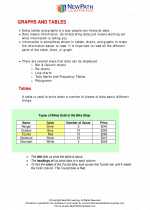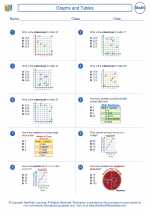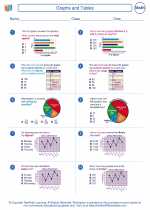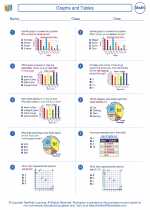Graphs and Tables -> histogram
Histogram
A histogram is a type of bar graph that represents the distribution of data. It is used to show the frequency of values within a data set. In a histogram, the horizontal axis represents the range of values, and the vertical axis represents the frequency or relative frequency of those values.
Key Concepts
- Frequency: The number of times a particular value occurs in the data set.
- Range: The span of values covered by the data set.
- Bar Height: The height of each bar in the histogram represents the frequency or relative frequency of the corresponding value.
- Intervals: The range of values is divided into intervals or bins, and each bar represents the frequency of values within that interval.
Creating a Histogram
To create a histogram, follow these steps:
- Determine the range of the data set.
- Divide the range into intervals or bins.
- Count the frequency of values within each interval.
- Draw a bar for each interval, with the height of the bar representing the frequency of values within that interval.
Example
Suppose we have the following data set representing the scores of 20 students in a math test:
| Score | 85 | 92 | 78 | 90 | 72 | 85 | 88 | 75 | 83 | 92 | 80 | 85 | 78 | 90 | 88 | 82 | 85 | 90 | 88 | 78 |
|---|
Let's create a histogram to represent this data:

Study Tips
Here are some tips for studying histograms:
- Practice creating histograms from given data sets.
- Understand the concept of frequency and how it relates to the height of the bars in a histogram.
- Study different types of histograms, such as relative frequency histograms and cumulative frequency histograms.
- Learn to interpret histograms and draw conclusions about the distribution of data.
With these study tips and a good understanding of the key concepts, you'll be well-prepared to work with histograms in your math studies!
[Histogram] Related Worksheets and Study Guides:
.◂Math Worksheets and Study Guides Fifth Grade. Graphs and Tables
Study Guide Graphs and Tables
Graphs and Tables  Worksheet/Answer key
Worksheet/Answer key Graphs and Tables
Graphs and Tables  Worksheet/Answer key
Worksheet/Answer key Graphs and Tables
Graphs and Tables  Worksheet/Answer key
Worksheet/Answer key Graphs and Tables
Graphs and Tables 

 Worksheet/Answer key
Worksheet/Answer key
 Worksheet/Answer key
Worksheet/Answer key
 Worksheet/Answer key
Worksheet/Answer key

The resources above cover the following skills:
Geometry (NCTM)
Specify locations and describe spatial relationships using coordinate geometry and other representational systems.
Make and use coordinate systems to specify locations and to describe paths.
Connections to the Grade 5 Focal Points (NCTM)
Data Analysis: Students apply their understanding of whole numbers, fractions, and decimals as they construct and analyze double-bar and line graphs and use ordered pairs on coordinate grids.